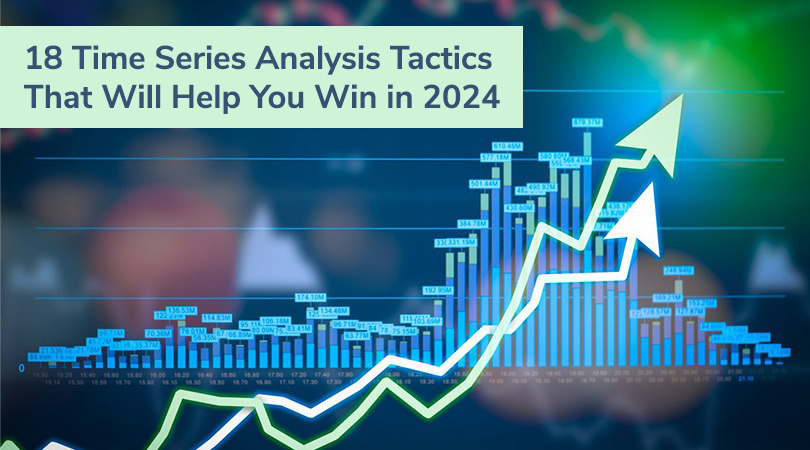Today, many companies have adopted time series analysis and forecasting methods to develop their business strategies. These techniques help in evaluating, monitoring, and predicting business trends and metrics. Time series analysis is beneficial and is commonly used for economic forecasting, yield projection, inventory studies, census analysis, sales forecasting, stock market analysis, and budgetary analysis.
What Is a Time Series?
Time series is an ordered sequence of data points spread over a period of time. Here, time is generally an independent variable while the other variable/s keep changing values. The time series data is monitored over constant temporal intervals. This data can be in any measurable and quantifiable parameter related to the field of business, science, finance, etc.
What is Time Series Analysis?
Time series analysis refers to identifying the common patterns displayed by the data over a period of time. For this, experts employ specific methods to study the data’s characteristics characteristics and extract meaningful statistics that eventually aid in business forecasting.
Learn Forecasting our Data science course designed for beginners for a better understanding of the concept.
Time Series Analysis and Forecasting Tactics
Certain features of the given time series aid in creating are used to create models that help predict assist in predicting business metrics and the future behaviour of business metrics. The better you can figure out the characteristics of the given data’s characteristics, the more accurate the forecasts will be. Below is an overview of 18 crucial concepts, methods, and things to know for efficient business forecasting:
1. Time series forecasting methods are a group of statistical techniques that can be vital for estimating different variables and be used for any business for estimating different variables.
2. To obtain accurate forecasts, you need to check for three essential features in a time series. These are autocorrelation, seasonality, and stationarity.
Autocorrelation and Seasonality
3. Autocorrelation is a mathematical term that indicates the extent of similarity between the given time series and its delayed version over a particular time. This time series refers to a set of values of a variable/entity.
4. Autocorrelation helps determine the relationship between current values and the past values of an entity. By using the past and current data, the professionals can identify and analyse the data patterns, establish relations, and plan for the future.
5. When an entity exhibits similar values periodically, i.e. after every fixed time interval, it makes way for measuring seasonality. For example, business sales of certain products show a similar increase in every festive season.
6. Seasonality lays the ground for predictability of the variable as per a particular time of the day, month, season, or occasion. With the help of seasonal variation data, the salespeople can devise their strategy ahead of that specific period.
Stationarity and Trends
7. When the statistical properties of a time series’ statistical properties remain constant over time, it is said to be stationary. In other words, the mean and variance of the series stay the same. Entities like stock prices are usually not static.
8. Stationarity of a time series is checked by conducting a KPSS test, Dickey-Fuller test, or extended versions of these tests. Methods to detect stationarity are primarily statistical in nature. These tests basically evaluate a null hypothesis in one way or the other.
9. Stationarity is regarded as quite crucial in a series, else a model displaying the data shows different accuracy at different time points. So, before modelling, the professionals use some techniques to transform a given non-stationary time series into a stationary one.
10. Trends are recorded over a long time. Depending upon the nature of the entity and related influencing factors, its trend may decrease, increase, or remain stable. For example, population, birth rate, death rate, etc. are some of the entities that mostly show movement and thus, cannot form a stationary time series.
Modelling Time Series Data
11. There are several ways to model the time series data. The three main types of time series models are moving average, exponential smoothing, and ARIMA. The crucial thing is to choose the right forecasting method as per the characteristics of the time series data.
12. Moving Average (MA) method is the simplest and most basic of all the time series forecasting models. This model is used for a univariate (one variable) time series. In a MA model, the output (or future) variable is assumed to have a linear dependence on the current and past values. Thus, the new series is created from the average of the past values. MA model is suitable for identifying and highlighting trends and trend cycles.
13. Exponential Smoothing (ES) method is one of the popular time series forecasting models. Like the MA method, ES technique is also used for univariate series. Here, the new values are calculated from the weighted average of past values. The older a value, the lesser is the weight assigned to it. As per the trends and seasonality of the variable, you may use the simple (single) ES method or the advanced (double or triple) ES time series model.
- Simple exponential smoothing method is used for a time series data with no trend or seasonality. In this method, a single smoothing factor or coefficient alpha (α) is used which decides the influence of past values on the forecast. If α is closer to ‘1’, the forecast is more impacted by the most recent values than the older values. The opposite is true if α is close to ‘0’.
- Double exponential smoothing method carries out the smoothing process twice, due to the presence of a trend in data. Apart from the factor alpha (α), another parameter beta (β) is used to regulate the trend change of the series. The trend may be linear or exponential, depending upon which the additive or multiplicative dampening effect is chosen.
- Triple exponential technique, also known as Holt-Winters Exponential Smoothing, includes smoothing at three levels because of trend and seasonality in data. So, besides the α and β factor, this method involves a gamma (γ) parameter to control the impact of seasonality in the series.
- Exponential methods are generally applied for economic or financial entities.
14. Autoregressive Integrated Moving Average (ARIMA) model is another widely used forecasting technique that involves the combination of two or more time series models. This model is suitable for multivariate non-stationary data. ARIMA method is based on the concepts of autoregression, autocorrelation, and moving average. In the case of seasonal data, a variation of the model called SARIMA is applied.
- SARIMA (Seasonal ARIMA) is basically an extension of ARIMA that considers the seasonal element of the time series. While ARIMA can analyse data with a trend, SARIMA supports data with both trend and seasonality. Besides the three trend factors of autoregression, difference, and moving average, SARIMA considers the three seasonal parameters for the same as well as a fourth factor for seasonal periods. The advantages of this model is that it can contain many parameters and their combinations.
Time Series Analysis in R or Python
15. R and Python are two programming languages commonly used for time series analysis. While R allows for a more specific statistical computing, Python extends a more general approach for data science. Python is easier and simpler to learn. However, the R statistical software offers a bigger ecosystem incorporated with in-built data analysis techniques.
16. Time Series Analysis in R:
R language includes several functions to manipulate, create, and plot the series data. This data is then stored in an ‘R object’ known as time-series object. The time-series object is represented by using the ts() function. The basic syntax for this function in time series analysis is:
timeseries.object.name <- ts(data, start, end, frequency)
where ‘data’ is a vector (single time-series), or matrix (multiple time-series) carrying the values., ‘start’ is the start time of the first observation in the given time series, ‘end’ denotes the end time of the last observation in the series, and ‘frequency’ refers to the observation count per unit time.
Apart from the ‘data’, all other variables are optional. Statisticians and academicians use the models that permit time series in R, because of its greater accuracy.
17. Time Series Analysis in Python:
Python makes use of Pandas software library, which is specifically designed for financial sector analysis and related estimations. This language involves time stamps (particular points of time), time deltas (total duration), and time periods (intervals). These basic objects containing dates and times are present in the in-built functionality. In addition to the in-built modules, data scientists sometimes use a third-party module to perform a variety of functions concerning particular dates and times. Professionals can utilise time series analysis to predict the future growth of the business.
18. Time series machine learning tools and techniques are considered extremely reliable for business development and forecasting. However, issues like noisy data, long sequences, multiple inputs/output variables, and multi-step forecasts may make it challenging. Nevertheless, the methods are advancing with the related programming languages being updated with more libraries.






![The Ultimate Guide to Statistical Analysis for Data Science [6 Step Framework]](https://www.excelr.com/uploads/blog/The_Ultimate_Guide_to_Statistical_Analysis_for_data_science_6_Step_Framework2.jpg)



